Fire is one of the most dangerous and damaging events that a business can experience. Many buildings have built-in fire protection thanks to the intumescent coatings on their interior walls, but these can only help control the spread of fire. It’s important to be aware of common workplace fire hazards so you can know how to prevent them. Keep reading to learn more.
Equipment Overheating
No matter where you work, any type of equipment can pose a fire risk due to overheating. In the traditional office setting, paper shredders can overheat and catch fire due to the flammable paper scraps nearby. In more industrial environments, processing equipment can overheat, which can generate friction or static electricity. So, it’s crucial to keep any type of flammable fluids, debris, and other materials away from electrical or processing equipment. Additionally, never push equipment past its limit. Turn off these pieces of equipment and allow them to cool to prevent fire hazards.
Misusing Electrical Equipment
Whether you work in a traditional office with the latest technology or in a workshop with industrial machinery, we all use and operate electrical equipment. Therefore, it’s important for us all to be well-versed in responsible electrical use and habits. Misusing electrical cables, outlets, and more can pose a huge fire risk for any business. Utilize training sessions to ensure that employees know safe electrical practices, such as how to safely plug in and unplug cables, where to lay cables and cords, and how to use extension cords.
Unique Fire Risks
Depending on your industry, your business may have unique fire risks that other buildings don’t. Industrial businesses typically use niche equipment that poses unique fire risks. For example, in metalworking, metal dust and debris can be easily ignited and cause a fire. Metalworking applications also utilize combustible and flammable liquids that you must keep away from heat-generating equipment.
Even something as simple as your workplace kitchen can produce unique fire hazards thanks to the cooking equipment. Employees must watch their cooking materials to ensure their items don’t catch fire or set off smoke alarms.
Ensure that your entire workplace understands these common workplace fire hazards and how to prevent them—by painting interior walls with a fire protection coating, turning off all electrical equipment at the end of a long workday, and properly storing any flammable liquids your business uses. Training sessions are the best way to share this information and help your entire team prepare for emergencies. When your team is knowledgeable of workplace fire hazards, they can better prevent them.

